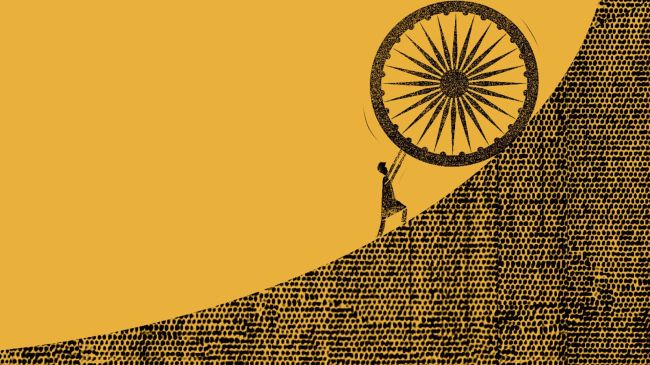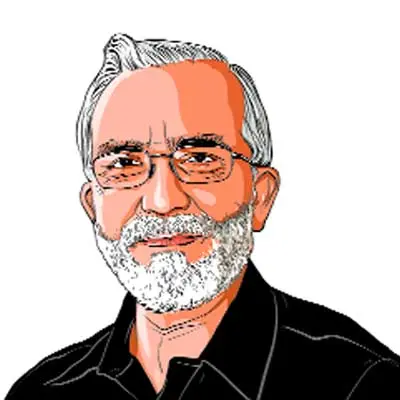Opinion Suhas Palshikar writes: Who stole my nationalism?
A spirited defence of Indian nationalism must also confront how it was undermined from the start. Belonging without othering was always under siege — today’s phoney nationalism has only finished the job
 The audacity of the project of Indian nationalism itself signified that it would have strong challenges and many inner hiccups. A fuller history of its rise and fall may include the failings of its supporters and the inaction of its well-wishers but the limitations of the nationalist project lay in its very audacity. (Illustration: C R Sasikumar)
The audacity of the project of Indian nationalism itself signified that it would have strong challenges and many inner hiccups. A fuller history of its rise and fall may include the failings of its supporters and the inaction of its well-wishers but the limitations of the nationalist project lay in its very audacity. (Illustration: C R Sasikumar) This is in response to Yogendra Yadav’s spirited exposition of “Indian” nationalism (‘The nationalism we forgot, IE, May 27). India’s imagination and practice of nationalism from the early 20th century was an audacious intellectual and political project by any standard. Its elaboration and defence in the piece by Yadav is a valuable reminder of what could have been. While agreeing with his description of Indian nationalism, it is necessary to also register a small but critical disagreement with his argument. As Yogendra bhai puts it, Indian nationalism is under assault today; it is being replaced by a “phoney nationalism”. And yet, he chides us that locating the problem only in the current moment would be wrong and lazy. That is where my disagreement may be located. Let me mention two disagreements. Following from them, there is a third disagreement about the trajectory of the challenge to Indian nationalism, coupled with a question on the semantics of “forgetting”, in the hope that this will broaden the scope of the debate.
One disagreement, which may seem like a quibble but is crucial to understanding the death of Indian nationalism, is the point about not locating the backsliding in what the current regime has done. Indeed, any major socio-political tendency has a deeper lineage than the present. In that sense, let us agree that merely blaming the currently fashionable idea of phoney nationalism is not an adequate analytical response to what has happened to the idea of Indian nationalism that promised “belonging without othering”. Nevertheless, it is not possible to ignore the present moment, which has formally and frontally disbanded Indian nationalism not merely through the subterfuge of practice but through the assault of ideology.

Today, “belonging” is replaced by a conditionality: One doesn’t belong, someone else decides who belongs, and who must belong, to the nation on the basis of one trait or the other. Is it not commonplace today to decide who is a Pakistani by identifying the person’s religion, irrespective of whether that person is a colonel or a district magistrate? Don’t we witness the othering of communities not just on the basis of religion, but also on the basis of the size of their eyes? So, one “belongs” only on the sufferance of those who claim to own this nation. Thus, the pseudo-nationalism of today doesn’t allow citizens to belong without preconditions and without tests of patriotism. A politics that mixes — via vigilante violence and state patronage — forced attachment and an ideology of othering has become the lingua franca of the phoney nationalism of today. Against this backdrop, the “backsliding” — or, in fact, disbandment and delegitimisation — of Indian nationalism must be located in the contemporary moment notwithstanding the failures to consolidate it in the past. As a matter of fact, it is not backsliding but a resolute replacement of Indian nationalism.
But of course, I would agree with Yadav that this process did not start in 2014 — or with Narendra Modi. December 1992 marked a major departure from the imagination of inclusion and accommodation. And as we know, December 1992 itself was a culmination of a long history of imagining the nation only through othering. This process formally took an organisational shape exactly a century ago. However, we still cannot ignore the significance and force that the decade since 2014 has brought to bear on the dramatic demise of Indian nationalism.
This long history of the gradual challenge thrown at Indian nationalism forces me to disagree with Yogendra bhai on a second point. He finds the post-Independence elite and the ruling ideology responsible for the disconnect between citizens and Indian nationalism. Again, let me begin with agreement. A section of “secular-liberal” elites did ignore the cultural dimension; it even overlooked the potential of traditions emanating from religion. But it is an exaggeration to blame this section for the crisis faced by Indian nationalism. This section was far too tiny to have any influence; worse, it was mostly English-speaking and lacked any real connection with the masses. On the other hand, not just the political class but a strong element among Indian language-speaking intellectuals were not averse to searching for sources of belonging from within Indian traditions and linguistic resources. They kept on struggling on the dual fronts of the meanings of traditions on the one hand, and the meaning of “Indian” on the other. It wasn’t just Gandhians and Lohiaites; even among communists, there was a recognition of the fact that traditions presented both things — elements of modernity and traditionalism, inclusive ideas as well as elements of exclusion.
Moreover, while we need not hesitate to admit the many failings of the elite and the political leadership of the post-Independence era, in holding them responsible for the current crisis of Indian nationalism, we may be making the mistake of ignoring the deep rivalry between Indian nationalism and its phoney alternative. Throughout the 19th century, a sense of identity rooted in othering and instrumental unity without genuine belonging began to emerge as the language of collective action — particularly among the upper castes. Religion was imagined devoid of religiosity, God was imagined without devotion, communities were imagined without empathy. These tendencies were alive and posed a challenge to Indian nationalism when it was nascent. While the nationalist movement succeeded in bringing an inclusive Indian nationalism to the centre stage, the alternative, too, was shaping up all through the late 19th and early 20th century.
most read
India’s elites — political, cultural and economic — were often torn between these two intellectual forces. While Mahatma Gandhi (and Jawaharlal Nehru) undoubtedly attracted many individuals from the upper castes, these same social sections were more favourably inclined to the narrow, vicious, macho and exclusionary European duplication of nationalism. Freedom in 1947 did not settle the deeper foundational dispute — it only postponed it. With occasional glimpses of superficial debates around Hindi and gau raksha in the 1960s, the simmering debate remained alive. For a variety of reasons of social turmoil and political deviations, the foundational dispute over the meaning of nationalism entered a critical phase around the 1980s.
The larger point, therefore, is this: The audacity of the project of Indian nationalism itself signified that it would have strong challenges and many inner hiccups. A fuller history of its rise and fall may include the failings of its supporters and the inaction of its well-wishers but the limitations of the nationalist project lay in its very audacity. Because it was ambitious, it was difficult to realise and more difficult to sustain but easy to malign. Its fall cannot be explained without realising that its ideological rival always existed. What has happened in the past three to four decades is that Indian nationalism has been effectively replaced by the phoney.
It’s not that I/we forgot Indian nationalism, it was stolen. The story of Indian nationalism should, therefore, not be a story of forgetting but the story of it being stolen.
The writer, based in Pune, taught Political Science




